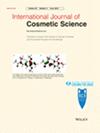Liposomes are often used in cosmetics since they are naturally derived and have excellent texture enhancing capabilities. However, when preparing them by using phospholipids with unsaturated acyl groups, they easily suffer from oxidative degradation. Accordingly, hydrogenated phospholipids are preferred, however, it is difficult to prepare stable liposomes due to its high gel-liquid crystalline phase transition temperature. On the other hand, although dialkyl dimethyl ammonium type cationic surfactants are widely known to form vesicles, they have rarely been used for skincare products except for water-in-oil type emulsion creams stabilized by organically modified clay minerals. We decided to overcome all of the problems above through ionic complex vesicles formed by double-tailed cationic and anionic surfactants.
Distearyl dimethyl ammonium chloride (DSAC) and sodium dilauramidoglutamide lysine (DLGL) were selected as cationic and anionic surfactants, respectively. Differential scanning calorimetry (DSC) and small- and wide-angle X-ray scattering (SWAXS) measurements were performed to confirm the DSAC/DLGL/water ternary phase diagram. Newly developed ionic complex vesicle formation was confirmed by cryogenic transmission electron microscopy (cryo-TEM). The adsorbed cosmetic film structure on the skin in vivo was evaluated through the polarized infrared external reflection (PIR-ER). Finally, a cosmetic lotion formula was developed and the vesicle size was determined by dynamic light scattering (DLS).
DSC and SWAXS data indicated that stable vesicles could be obtained at a molar ratio of DLGL to DSAC = 6:4. At this molar ratio, multi lamellar vesicles with diameters less than 100 nm were observed through cryo-TEM. PIR-ER data revealed that the developed vesicles formed a highly perpendicular orientation to the human skin surface. We have succeeded in formulating a cosmetic lotion containing developed vesicles with a mean diameter of 63.2 nm, which was stable over 1 month at 0, 37, and 50°C.
Our newly developed vesicles can be easily obtained through a coagulation process. Also, the adsorbed film structure supported by PIR-ER experiments implies that the developed lotion has an excellent texture that is the same as cosmetic lotions containing liposomes. Therefore, it's possible that this ionic complex vesicle could take the place of liposomes.


